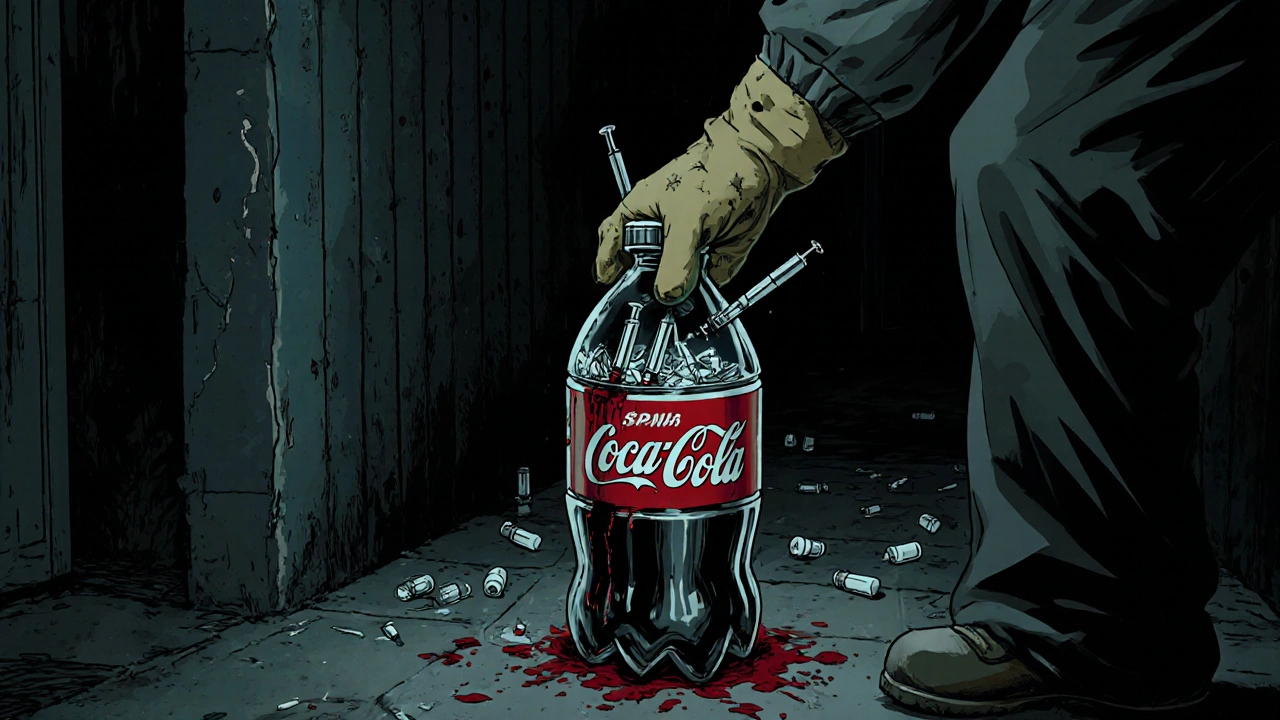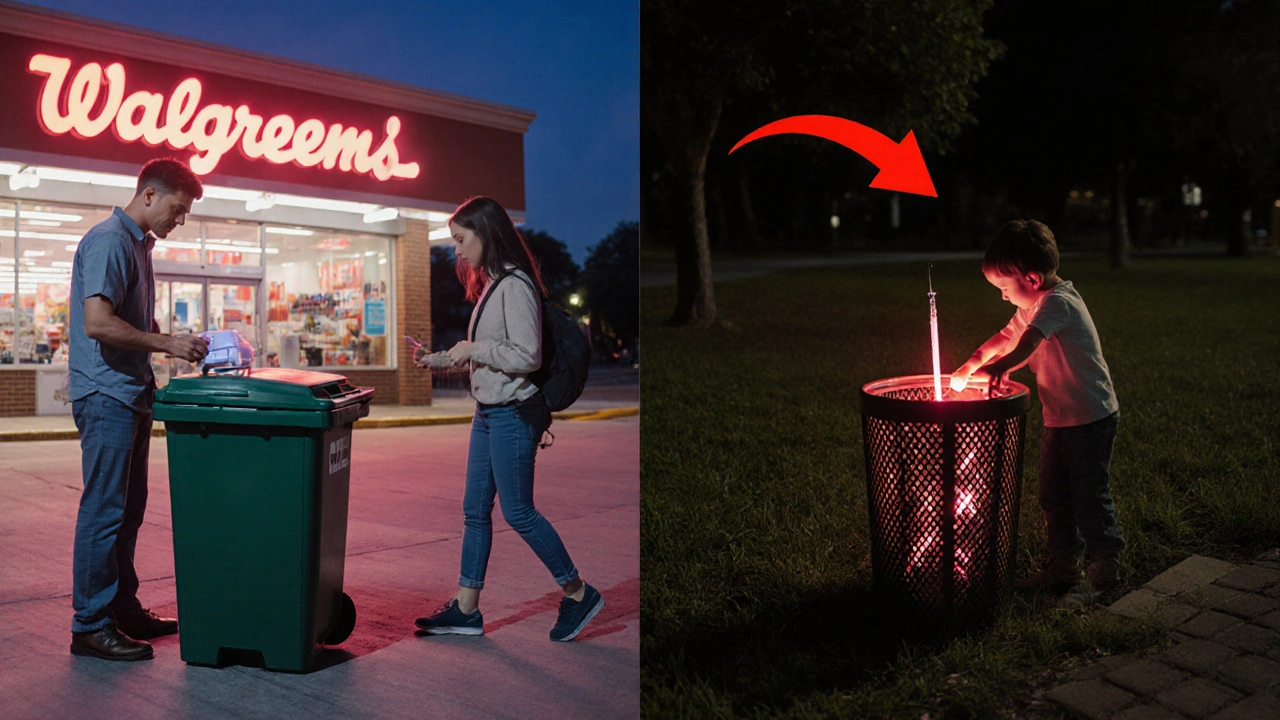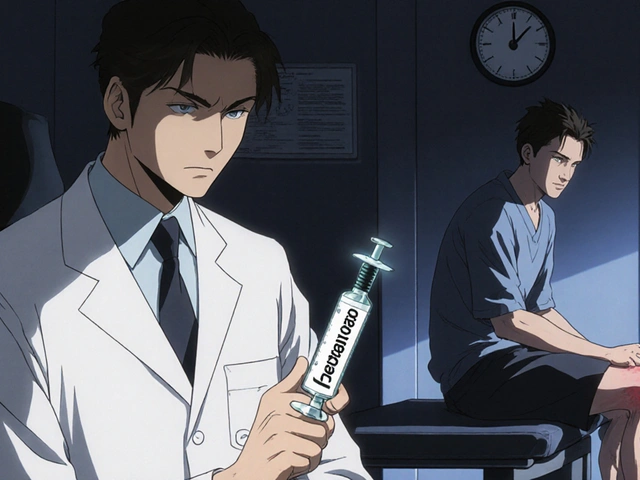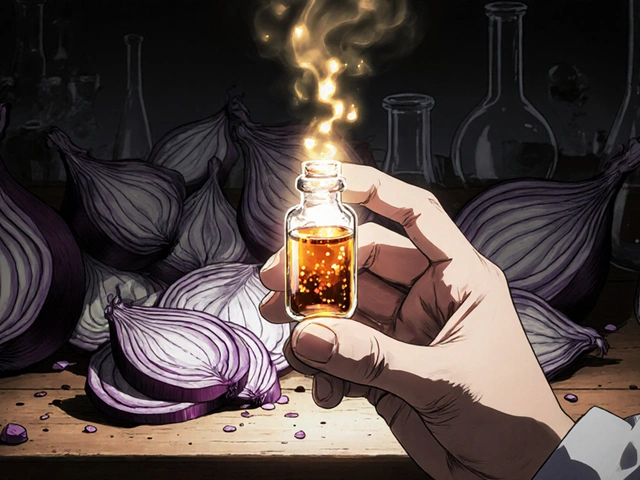Why Proper Sharps Disposal Matters
Every year, over 385,000 needlestick injuries happen in healthcare settings alone - and that’s just the ones that get reported. Most of these injuries happen because someone didn’t use the right container or tried to recycle a syringe into a soda bottle. But this isn’t just a hospital problem. At home, people with diabetes, multiple sclerosis, or other conditions that require injections are at risk too. A single accidental stick can expose you to HIV, hepatitis B, or hepatitis C. The risk isn’t small: hepatitis B can spread in up to 30% of cases after a needlestick. That’s why proper disposal isn’t optional - it’s life-saving.
What Counts as a Sharp?
You might think only needles are dangerous, but sharps include anything that can cut or poke you after being used. That means:
- Needles (for insulin, vaccines, or other injections)
- Syringes (even if they’re not attached to a needle)
- Lancets (the tiny blades used for finger pricks)
- Auto-injectors (like EpiPens after use)
- Insulin pens with attached needles
- Capillary tubes and scalpels
If it was used to give medicine or draw blood, and it’s sharp, it belongs in a sharps container. Never toss these into your regular trash, recycling, or compost. Even a used needle that looks harmless can carry dangerous germs.
What’s a Proper Sharps Container?
Not just any plastic bottle will do. The FDA requires sharps containers to meet strict safety standards. Look for these features:
- Thick, puncture-resistant plastic (at least 0.04 inches thick)
- A tight, one-way lid that won’t let your fingers slip in
- A clear fill line - never go past the 3/4 mark
- A biohazard symbol (the three-bladed warning sign)
- Sturdy base so it won’t tip over
Brands like BD Redi-Sharp, Sharps Compliance Safe•Drop, and Stericycle containers are FDA-cleared. These aren’t just plastic boxes - they’re engineered to stop injuries. For example, BD’s one-way opening design prevents accidental hand insertion, cutting needlestick risks by 94% in lab tests.
Don’t use old juice bottles, laundry detergent jugs, or coffee cans. They crack, leak, or get punctured. In 2023, the FDA reported that 68% of home sharps injuries happened because people used improper containers.

How to Use the Container Correctly
Even the best container won’t help if you use it wrong. Follow these steps every time:
- Immediately after use, place the sharp into the container. Don’t wait. Don’t set it on the counter.
- Never recap, bend, or break the needle. That’s one of the most common mistakes.
- Keep the container within arm’s reach while injecting - no more than 6 feet away.
- Fill only to the 3/4 line. If you can see the sharps from the top or through the window, it’s full.
- Close the lid securely after each use. Don’t leave it open.
Most home users don’t get proper instructions. In fact, a 2023 FDA survey found only 41% of people using injectable meds at home were told how to dispose of sharps. If you weren’t told, now you know.
Where to Drop Off Full Containers
Once your container is full, you can’t throw it in the trash. Here’s where to take it:
- Pharmacies: Many Walgreens, CVS, and Rite Aid locations have drop-off bins. Just ask at the counter. Walgreens’ program has a 4.6-star rating across hundreds of reviews for being easy and free.
- Hospitals and clinics: Most offer free disposal for patients, even if you didn’t get your meds there.
- Local health departments: Many cities run free sharps collection days or permanent drop-off sites.
- Mail-back programs: Companies like Sharps Compliance offer prepaid envelopes. You seal your full container, drop it in the mailbox, and they handle the rest. Cost: $15-$30 per box.
Check your state’s health department website or call the EPA’s medical waste hotline for a list of local drop-offs. If you live in a rural area, you’re not alone - only 37% of rural counties have accessible disposal sites. Mail-back programs are often the only option.
Costs and Financial Help
Yes, sharps containers cost money. A 1.5-gallon container runs $8-$13. Mail-back boxes are $15-$30. That adds up - about $147 a year per person. But here’s the real math: if you get stuck, the average cost of post-exposure treatment (blood tests, antiviral drugs, follow-ups) is over $3,200. That’s why insurance often covers containers and mailers.
Medicare Part B covers sharps containers and disposal supplies if you’re on injectable therapy at home. Many private insurers do too. Ask your pharmacy or doctor to help you file. Medicaid and state health programs often provide free containers to low-income patients. Don’t assume you can’t afford it - help is out there.

What Happens If You Don’t Dispose of Sharps Properly?
Improper disposal doesn’t just hurt you - it hurts everyone else. Trash collectors, sanitation workers, and even kids playing near dumpsters can get stuck. In 2022, a child in New Jersey was hospitalized after finding a used insulin needle in a park trash can. That’s why states like California and New York have strict rules: containers must be red, locked, or labeled a certain way.
Healthcare facilities face heavy fines too. OSHA issued 184 citations in 2023 for improper sharps handling, with penalties averaging over $2,500 each. For home users, there aren’t usually legal penalties - but the risk of infection, lawsuits, or harming someone else is very real.
What’s Changing in 2025 and Beyond
Regulations are getting stricter. Starting December 1, 2025, OSHA will require employers to provide take-home disposal kits to home healthcare workers. By 2028, the FDA expects all new sharps containers to have smart sensors that warn when they’re full. That means containers may soon beep or glow when it’s time to drop them off.
States are also moving toward standardization. The EPA’s 2024 update will require the same biohazard label on all containers nationwide by January 2026. That’s good news - no more guessing what’s allowed where.
Final Tips for Safe Handling
- Keep containers out of reach of children and pets - even when they’re not full.
- Label the container with your name and date you started using it.
- Never flush needles down the toilet. That pollutes water systems and can damage pipes.
- If you drop a needle, don’t pick it up with your hands. Use tongs or pliers, place it in a container, and wash your hands.
- Always have a spare container on hand. Running out is when people make dangerous choices.
Proper disposal isn’t about following rules - it’s about protecting your family, your community, and yourself. It takes less than 10 seconds to drop a needle in the right container. That small action saves lives.
Can I throw needles in the regular trash if I put them in a bottle?
No. Even if you put needles in a plastic bottle, they can still puncture through and injure waste workers, children, or pets. Only FDA-cleared sharps containers are designed to safely contain used sharps. Household containers are not strong enough and are illegal to use for this purpose in most states.
Are there free sharps disposal programs?
Yes. Many pharmacies like Walgreens and CVS offer free drop-off bins. Local health departments, hospitals, and some nonprofits provide free containers or mail-back kits - especially for low-income patients. Medicare and Medicaid often cover the cost of disposal supplies. Call your state’s health department or visit the EPA’s medical waste directory to find free options near you.
How do I know when my sharps container is full?
Every FDA-approved container has a fill line - usually marked at the 3/4 level. If sharps are visible at the top or through the window, it’s full. Never force more in. Overfilling is the second most common cause of needlestick injuries. When in doubt, seal it and drop it off.
Can I reuse a sharps container?
Only if it’s specifically labeled as reusable and approved by the FDA. Most home users get single-use containers. Reusable containers require professional sterilization and are not recommended for personal use. Never try to clean a used container at home - it’s unsafe and ineffective.
What should I do if I get stuck by a used needle?
Wash the area with soap and water right away. Don’t suck or squeeze the wound. Call your doctor or go to urgent care immediately. You may need blood tests and preventive treatment for hepatitis B, hepatitis C, or HIV. Report the incident to your local health department - it helps track risks and improve safety.




Deepak Mishra
November 16, 2025 AT 06:28Rachel Wusowicz
November 16, 2025 AT 08:16Latrisha M.
November 17, 2025 AT 11:48John Mwalwala
November 19, 2025 AT 07:38Diane Tomaszewski
November 19, 2025 AT 08:15Dan Angles
November 20, 2025 AT 08:57David Rooksby
November 20, 2025 AT 09:56Teresa Smith
November 22, 2025 AT 04:39Melanie Taylor
November 23, 2025 AT 15:01Daniel Stewart
November 24, 2025 AT 08:22